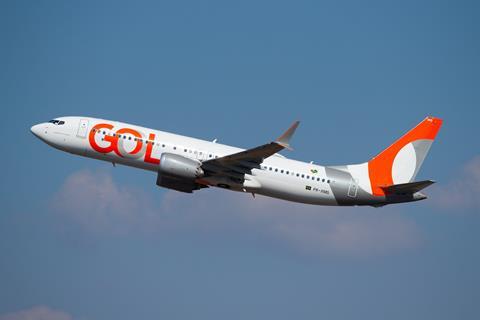Brazilian airline Gol has submitted a five-year financial plan to a US court as part of its bankruptcy proceedings that calls for refinancing $2 billion in debt, an equity raise, and new deals with aircraft lessors.
The financial plan is “expected to serve as the foundation” for the Sao Paolo-based carrier’s reorganisation, it disclosed on 27 May.
Gol had filed for Chapter 11 bankruptcy protection in a US court in January in order to restructure its obligations. It is the fourth Latin American carrier to pursue the process in the wake of the disruption of the Covid-19 crisis. In 2020, Aeromexico, Avianca and LATAM Airlines all restructured their finances under the Chapter 11 rules.

“We are pleased to reach another important milestone in our financial restructuring process,” chief executive Celso Ferrer says. “Since the start of this process, Gol has continued operating successfully in the normal course and demonstrated strong execution of our commercial strategy while maintaining a disciplined approach to managing costs.”
The five-year plan targets domestic capacity returning to pre-coronavirus levels by 2026, and an expansion of both domestic and international networks. The airline aims to grow its all-Boeing 737 fleet to 169 aircraft by 2029, up from the 141 aircraft it had at the end of the fourth quarter 2023. Of those, 91 were older-generation NGs, 44 were Max variants, and six were cargo jets.
Gol still has 101 orders for further Max aircraft, including for 64 examples of the Max 8 and 37 for the uncertificated Max 10 model.
The airline’s plan also sees its EBITDA margin – expressed as a percentage of total revenue – as being ”depressed” in 2024 at about 23%, versus 27% in 2023. However, it is expected to rebound to about 29% in 2025, 30% in 2026 and 34% by 2029.
FLEET GROWTH
The airline has also now “successfully renegotiated agreements for a substantial majority of our aircraft” with lessors, and is increasing the size of its operating fleet and capacity.
As of 24 May, the bankruptcy court approved agreements for 113 aircraft and 48 spare engines that include “meaningful lease concessions” as well as “significant engine maintenance support”, the company says. Gol is now reviewing competitive offers of concession packages from lessors covering almost all of its remaining aircraft and will make decisions about those aircraft “shortly”.
“In total, the concession packages from lessors are expected to provide the company with the financial support necessary to overhaul all engines required to rebuild its capacity to levels consistent with the five-year plan,” the company says.
As a result, Gol expects 2024 capacity to be temporarily below 2023, thus impacting earnings as well. Gol has also received approval to finance new aircraft and engine deliveries and expects to continue taking new 737 Max deliveries during the restructuring process and thereafter.
EXIT FINANCING
Gol’s exit financing process will involve refinancing about $2 billion in debt and it plans to acquire about $1.5 billion in new capital through issuing new shares. That equity raise will allow the carrier to repay its existing debtor-in possession (DIP) financing of $1 billion, while adding incremental liquidity to the balance sheet. Gol says it will solicit proposals in a competitive process beginning in early June, through the third quarter and possibly into the fourth as well.
“While Gol anticipates a successful exit financing process, there can be no assurance that the process will result in any transactions,” the company says.
Ferrer adds that the five-year plan ”serves as a clear roadmap for our next phase, during which we will continue to advance our long-term strategies of improving the travel experience, including affordability of travel and customer choice to expand our position as a leading airline in Latin America”.
“With a clear plan in place, we can begin preparing for the competitive exit financing process we will begin shortly as a means of ensuring Gol has the strongest possible financial foundation upon our emergence from Chapter 11,” he says.
Gol joined with Colombia’s Avianca in May 2022 in forming the holding group Abra, which was touted as an opportunity for the airlines to better compete in international long-haul and cargo markets and to launch new flights. Under the agreement, both carriers maintain their individual brands, strategies and teams – a move intended to create long-term stability in the post-Covid-19 environment.
The structure is controlled by the principal shareholders of Avianca and the majority shareholder of Gol, and led by Latin American airline veterans. Adrian Neuhauser, formerly chief executive of Avianca, ascended to the Abra chief executive post at the beginning of 2024.


























